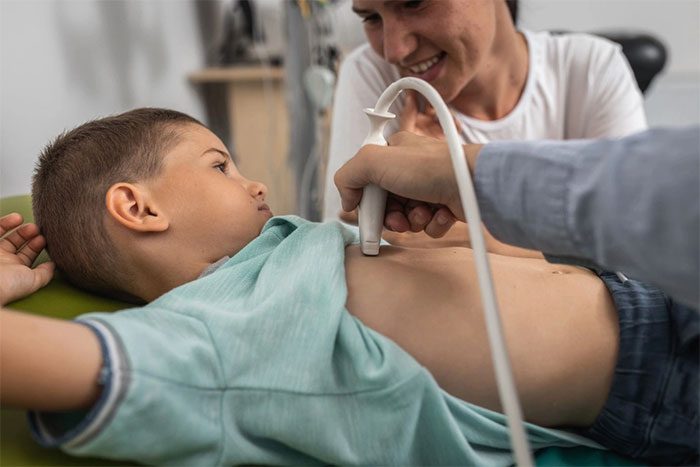Interstitial Lung Disease (ILD) is quite rare in children. However, if a child has other respiratory conditions, is frequently exposed to pollution, or has a family history of such diseases, they may face a higher risk of developing this condition.
According to the National Heart, Lung, and Blood Institute (USA), childhood interstitial lung disease (chILD) is a group of rare lung diseases that can affect infants, children, and adolescents. It is also referred to as diffuse lung disease.

Symptoms of interstitial lung disease in children include shortness of breath, rapid breathing, wheezing, and coughing. (Image: Rheumatology Advisor).
These diseases can present several symptoms such as shortness of breath, rapid breathing, and coughing. They can also damage the lungs similarly, making it harder for oxygen to pass through the lungs and enter the body.
Some children are born with interstitial lung disease (ILD), while others may develop it later during childhood. ChILD can range from mild to severe and can be life-threatening.
Some types of chILD may worsen over time, while others may improve or show no progression. Currently, there is no cure for chILD, but early diagnosis and treatment can help improve symptoms.
Common Types of chILD
Some common types of chILD in children under 2 years old include:
- Developmental disorders such as alveolar capillary dysplasia: These issues arise from the lungs developing improperly before birth. They are often severe and symptoms may be noticeable within days after birth.
- Genetic surfactant disorders: Surfactant is a substance that coats the inside of the lungs, helping them function better. Mutations or changes in the genes that control how a child produces surfactant can lead to lung damage.
- Neonatal pulmonary hyperplasia (NEHI): This is a rare lung disease that causes rapid, noisy breathing and low oxygen levels. Researchers have not yet identified the cause of NEHI. It is also known as persistent rapid breathing in infants.
Types of chILD can occur in children of all ages and may be due to infections, other lung diseases, or issues with the immune system. Additionally, dust or mold in the environment can cause hypersensitivity pneumonia and obstructive bronchiolitis.

If medications are ineffective or symptoms worsen, children may require oxygen therapy or ventilator support. (Image: Verywell Health).
Symptoms and Diagnosis
Symptoms of interstitial lung disease in children include:
- Rapid breathing, flaring nostrils, wheezing, or making sounds while exhaling. Respiratory issues are commonly observed in infants while feeding and in older children during physical activity.
- Chest retraction during breathing.
- Chronic coughing.
- Growth and developmental problems.
- Cyanosis (bluish skin).
- Enlarged and rounded fingers or toes.
Healthcare centers will diagnose chILD based on medical history, family history, physical examinations, and results from lung tests, blood tests, and genetic testing.
Causes and Risk Factors
Genetic factors, infections, or significant exposure to harmful substances in the environment that damage the lungs can cause chILD. This lung damage can lead to inflammation and scarring in a child’s lungs.
Lung issues that develop before birth can also cause this disease. Often, doctors may not even know the cause of interstitial lung disease in children.
Interstitial lung disease in children is very rare. Therefore, most children are not at risk of developing it. However, environmental factors, family history, medications, and other medical conditions can increase the risk of chILD.
- Environment: Frequent or prolonged exposure to environmental substances such as bacteria, fungi, chemicals, cigarette smoke, and air pollution can increase the risk of chILD.
- Family history: Mutations or changes in genes that control lung development can lead to chILD. These changes may affect how the body produces lung surfactant. Young children are at higher risk for certain types of chILD if others in the family have had ILD or other medical conditions that may cause chILD.
- Lifestyle habits: Hazardous substances like cocaine can damage the lungs and lead to chILD. This is more common among adolescents.
- Medications including radiation therapy, chemotherapy, immunosuppressants, antibiotics, heart medications, and anti-inflammatory drugs can all contribute to the development of interstitial lung disease in children.
- Other health issues that affect the lungs can increase the risk of chILD, such as asphyxia, rheumatoid arthritis, vasculitis, bacterial or viral infections, lung cancer, metabolic issues, or complications following lung transplants.
Treatment
Currently, there is no cure for chILD. Doctors may prescribe medications to help slow or stop lung damage, making it easier for children to breathe. Treatment for chILD depends on the type and cause. If medications are ineffective or a child’s symptoms worsen, they may require oxygen therapy or ventilator support.


















































